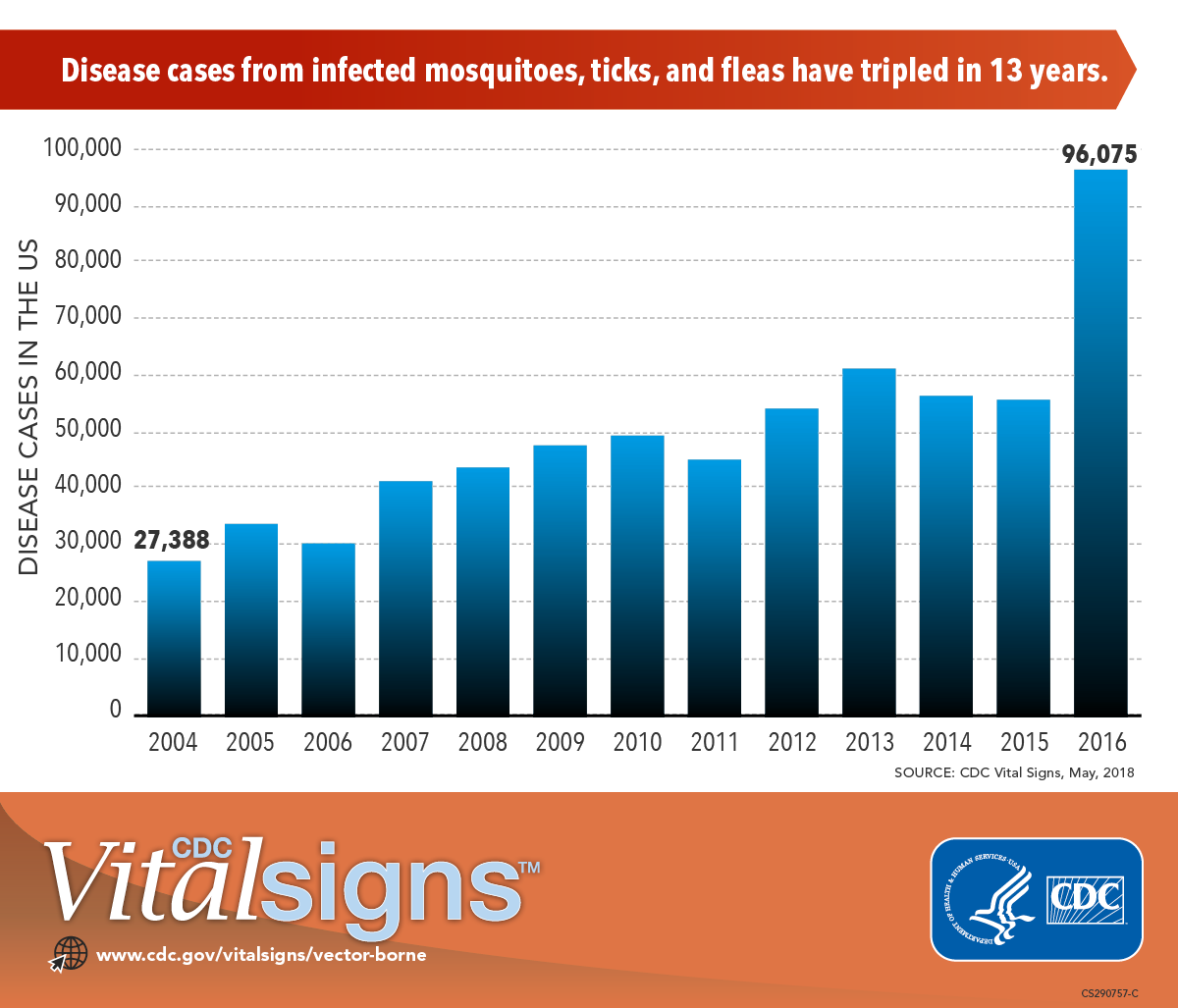Vector-borne diseases more than triple in US, CDC says
Click Here to Manage Email Alerts

The number of illnesses caused by the bite of infected mosquitoes, ticks and fleas has more than tripled in the United States, and the country is not fully prepared to handle the increased burden, CDC officials said today.
According to data from a new CDC Vital Signs report, more than 640,000 cases of vector-borne illnesses like Zika, West Nile virus and Lyme disease were reported to the National Notifiable Disease Surveillance System (NNDSS) by state health departments from 2004 through 2016, although the actual total is thought to be much higher.
The annual number of reported cases increased from 27,388 to 96,075 over that time because of a variety of factors, including increased travel, a larger number of mosquito and ticks spread out over a wider area, the discovery of nine new pathogens, and the addition of several illnesses to the list of nationally notifiable vector-borne diseases.
Climate change, although not explicitly mentioned in the report, is thought to be a major factor in the spread of vectorborne illnesses, especially Lyme disease, as ticks move northward into areas that were previously too cold for their survival.
“The bottom line is illnesses from mosquitoes, ticks and flea bites continue to impact our nation,” CDC Director Robert Redfield, MD, said in his first telebriefing since he was appointed to lead the federal health agency. “The threat of disease spread by mosquitoes, ticks and fleas are increasing. With the warm weather and summer travel rapidly approaching, we know that we are vulnerable to these diseases.”
Reported cases
The new data include only cases that have been reported by state and local health departments. The actual burden is thought to be “substantially higher,” researchers wrote. For example, they cited a recent estimate of approximately 300,000 annual cases of Lyme disease — up to 10 times the number reported to the NNDSS.
The 16 vector-borne illnesses that state health departments are required to report include nine mosquito-borne diseases — West Nile, dengue, chikungunya and Zika among them — and six tick-borne diseases, including Lyme, which is by far the most prevalent vector-borne disease in the country, with more than 402,000 cases reported over the study period. Plague, the only nationally notifiable flea-borne illness in the country, remains rare and is mostly reported from the Southwest, where it is associated with prairie dog dens.
The nine new threats reported in the U.S. since 2004 include seven new tick-borne pathogens, including the Heartland and Bourbon viruses in the Midwest and a new Borrelia species — B. mayonii — that has caused Lyme disease in the upper Midwest.
Among mosquito-borne viruses, chikungunya and Zika have caused outbreaks in the U.S. for the first time, both being introduced first in Puerto Rico. Most reports of chikungunya, dengue and Zika — three diseases spread by Aedes mosquitoes — came from Puerto Rico, the U.S. Virgin Islands and American Samoa, researchers said, but the mainland U.S. also saw many cases, including locally transmitted cases of Zika in Florida and Texas.
Data have shown that Zika, once thought to be a benign virus, has caused numerous birth defects in the U.S. Zika and West Nile, which has caused epidemics since it was first introduced in the U.S. in 1999, were the most commonly reported mosquito-borne diseases in the continental U.S.
Environmental factors
The CDC report mentions the complex impact of the environment on vector-borne disease epidemiology, including the effect of rainfall, temperature and shelter on the “longevity, distribution, biting habits, and propagation of vectors, which ultimately affect the intensity of transmission,” but it does not specifically mention rising global temperatures.

Lyle R. Petersen, MD, MPH, an Infectious Disease News Editorial Board member and director of the CDC’s Division of Vector-Borne Diseases, said warmer temperatures allow ticks to move farther north, increasing their range and extending the length of tick season, which places more people at risk for infection. Petersen said higher temperatures also raise the risk for mosquito-borne diseases.
“What I can say is that any of these diseases are very sensitive to temperatures, so when there are increasing temps, it promotes several things,” Petersen said. “One is that mosquito-borne diseases tend to get worse during heat waves. Higher temperatures tend to make mosquitoes more infectious and infectious faster, thus promoting outbreaks. For tick-borne disease, increasing temperatures will tend to expand the range of these ticks farther north as well as increasing the length of tick season.”
Petersen also noted that humans have moved into areas where there are more deer, putting them at higher risk for tick-borne diseases.
Prevention and control
According to the report, around 80% of state and local health departments and vector control organizations — what Redfield called the country’s “first lines of defense” against vector-borne diseases — are unprepared to handle the increased burden of vector-borne diseases, lacking critical prevention and control capacities.

Redfield said the growing burden of vector-borne disease has increased the demand on these organizations and said the CDC must continue to support and enhance their ability to combat them. Petersen said the agency is using two strategies to better prepare the organizations to prevent and control the threats.
“First, we’re working to expand the number of effective and publicly accepted mosquito prevention and control options. Second, CDC is working with state and local health departments to build or rebuild comprehensive vector programs that have eroded over time,” he said.
IDSA response

Paul Auwaerter, MD, president of the Infectious Diseases Society of America, said vector-borne diseases “can devastate patients and their families, causing significant suffering,” and that the IDSA urges Congress to increase funding for surveillance and prevention efforts, including resources to support finding the best prevention methods.
Auwaerter said the IDSA is investigating the role that climate change plays in the spread of vector-borne diseases “so that we can take appropriate actions to protect public health.” He said the organization advocates for federal investments in the research and development of new vaccines to prevent Zika, Lyme disease and other serious vector-borne diseases.
“While all possible efforts must be made to prevent vector-borne diseases, we also wish to ensure rapid, accurate diagnosis and optimal treatment for patients who are sickened,” he said. “We support boosting resources for research and development leading to improved diagnostics for Lyme disease and other vector-borne diseases by the National Institutes of Health and the Biomedical Advanced Research and Development Authority. We also support funding for research to understand better how to safely and effectively treat symptoms that persist in some patients following initial antibiotic treatment for Lyme disease.” – by Gerard Gallagher
Reference:
Rosenberg R, et al. MMWR Morb Mortal Wkly Rep. 2018;doi:10.15585/mmwr.mm6717e1_w.
Disclosures: Auwaerter, Petersen and Redfield report no relevant financial disclosures.

